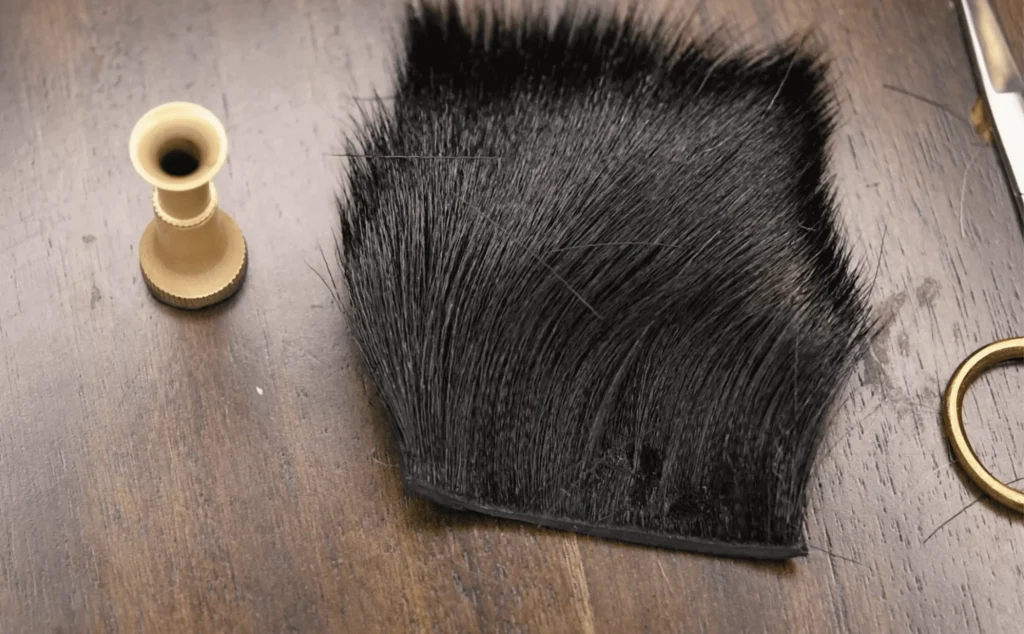How to Fish and Tie the Letort Cricket

In my box of terrestrial tricks, you’ll invariably find the Letort Cricket. Developed by Ed Shenk in the 1950s, Shenk often touted the Letort Cricket as his most effective fly, and he wasn’t wrong. He said he’d used it to catch trout on rivers all across the United States as well as Argentina, and although I have yet to test it on international waters, I can tell you it takes plenty of trout on local waters here in the Great Lakes Region.
Hopper patterns, it seems, are a dime a dozen. Good cricket patterns aren’t so common. Granted, the Letort Cricket is simply an all-black variation of Shenk’s Letort Hopper – in fact, many cricket imitations are just variations of hoppers. But if you look in the boxes of a dozen fly anglers, I’m not sure how many patterns you’d find to imitate crickets. Hoppers, beetles, and ants rule the terrestrial game.
But there’s a place for the cricket, and especially the Letort Cricket. As legend has it, Shenk came up with this pattern after witnessing cagey Letort Spring Run brown trout selectively feeding on crickets one morning. He went home, spun up this variation of his Letort Hopper, returned to the stream, and caught fish.
When to Fish with Crickets
As with most hopper patterns, cricket patterns seem to start working in late spring but come into their own during late summer and early fall. They remain active as long as the air temperature exceeds 50 degrees F. When it drops below that, they go into a hibernation phase. There’s an old saying that “when crickets stop singing, winter starts.” Not literally, of course, but once you stop hearing crickets singing, you can usually start expecting some frosty nights.
Most years, crickets remain active until mid-October in the northern states, and later as you move southward. Therefore, cricket patterns will continue to work, too. I’ve always correlated this with the brown trout spawn, which is triggered by both a drop in temperature (low to mid forties) and photoperiodism (shorter days).
It typically takes some very cold autumn nights for the water to drop into the forties, which means crickets will be less active; in fact, most adult crickets will die during these times. But before they do, they will have deposited their eggs, which enter a diapause period, a complete dormancy similar to suspended animation. All body functions and biological functions cease, and they can be frozen solid.
Next spring, though, with warmer days and nights, crickets get more active, and by summer they’re out in full force. They’re prolific, too, and can have multiple broods per season. It’s common to find them in a full range of sizes, from large adults to small “nymphs.” When you’re walking to the stream and notice crickets springing from the weeds at your feet, you’ll know it’s time to consider tying on your favorite cricket imitation, which for me means tying on a Letort Cricket.

Why I Like the Letort Cricket
The Letort Cricket has a deer hair head and wing, which makes it not only buoyant, but natural. Although there’s nothing wrong with foam-bodied flies (I use a lot of those, too), I often shy away from them on waters with spooky trout simply because they tend to “splat” a lot more on the water. A deer hair fly, though, will land softer.
I also like the “representative” nature of deer hair flies, particularly the Letort Cricket. In various situations, they can imitate any number of species. A Letort Cricket can imitate a cricket, of course, but it can also represent a beetle, a dark hopper, or any number of land-born insects that occasionally find their way into the water.
I’m not afraid to sink this pattern, too, and fish it like a nymph. Many anglers exclusively fish crickets and hoppers on top, and indeed that provides the most exciting action, but they can be deadly underneath. Many terrestrial insects drown upon falling into the water and are taken subsurface, and fishing a Letort Cricket under an indicator can produce awesome results. This is a distinct advantage over foam-bodies flies.
The Letort Cricket is an Ed Shenk pattern, which means it has a special place in my heart. I grew up reading the works of Shenk and his tales of fishing the Letort, and his cricket is my first choice simply for nostalgic reasons. And it also doesn’t hurt that 70 years after its development, it still works quite well!
Perhaps the main reason I like the Letort Cricket is because it can be tied very small. I’ve seen this fly tied on 3XL shank hooks, similar to those used for grasshopper flies, but in my opinion, this fly works best on 2XL shanks, and even a standard-shank dry fly hook, which gives it a smaller profile. Most crickets where I fish have short, compact bodies, and a Letort Cricket tied on a size 16 2XL shank hook is a very close match.
How to Tie the Letort Cricket
Materials need to tie the Letort Cricket:
Hook: Model 4 from Wholesale Fly Company. This is a 1XL dry fly hook that I use for Letort Crickets in sizes 12-14. For smaller size 16, I prefer 2XL hooks such as the Daiichi 1280, or the Moonlit TOGATTA ML411 if needing a barbless option.
Thread: Black in 6/0 or 8/0, Semperfli Classic Waxed Thread is preferred.
Abdomen/Body: Black Superfine Dry Fly dubbing. Or for a really neat variation, try a dark, mottled color of Semperfli’s Dirty Bug Yarn.
Wing: Turkey, Duck, or Goose Slip from a wing feather.
Overwing and Head: Black Dyed Deer Hair.
Recommended Tools: A Stonfo Razor Holder and blades comes in handy for trimming and shaping deer hair on flies of all sizes. These adjustable blades are easy to work with and do a great job on each very small flies.
The key to tying an effective Letort Cricket is using a 2XL hook. Many sources that I’ve come across recommend a 3XL shank. That’s too long, in my opinion, because it takes the fly’s profile more in line with that of a hopper. Although their bodies are similar, most crickets have shorter, more compact bodies. This also lends to their versatility to imitate beetles as well as crickets.
For sizes 12 and 14, I like the Model 4 from Wholesale Fly Company, which is a 1XL dry fly hook. For size 16, I prefer a 2XL hook, such as the Daiichi 1280 2XL Dry Fly Hook, or the Moonlit TOGATTA ML411 if in need of a barbless option. The extra length comes in handy on small sizes because of the amount of materials used to tie the Letort Cricket. I cannot stress enough the importance of not crowding the hook eye on this pattern.
Start by attaching some black 6/0 thread for larger flies or black 8/0 for smaller ones to the hook shank. When tying on size 16, you may even consider 12/0. However, when learning to tie the Letort Cricket, you may find it easier to learn by tying sizes 12 and 14 first so that you get a good feel for thread strength and how hard you can pull to secure the deer hair wing and spin the head.
For this reason, I strongly recommend Semperfli Classic Waxed Thread. As I’ve often mentioned in my fly tying videos and articles, Semperfli has excellent strength-to-diameter, and will do a better job of locking down that deer hair without creating a bulk behind the hook eye. This is a very important factor to consider because the deer hair is naturally bulky, and you don’t want to crowd the hook eye any more than necessary when tying off the fly.
Next, create a thin dubbing noodle on the thread. Standard black dubbing works well for the abdomen (body). You can keep this thin or make it bulky if desired. If you want to add more dimesion to your Letort Cricket, use a mottled black/brown dubbing for the body, or even Semperfli Dirty Bug Yarn in Black. Dirty Bug Yarn is slightly fuzzy, which will give the fly more life in the water. (A great variation of this pattern is to use Dirty Bug Yarn in Mottled Olive or Dark Olive for the body. Crickets have an iridescence with hints of brown and green depending on how the sun hits their bodies.)
Regardless of material used for the body, advance it to a little less than halfway up the hook shank to allow plenty of room for the wing and head.

Next, clip a narrow slip from a duck or turkey wing to use as the wing on the Letort Cricket. I like the tip of the slip to extend back over the bend of the hook. When placing the slip on the hook shank over top of the dubbed body, I like to use my thumb and forefinger to shape it over the cylindrical body. Use a couple loose wraps to attach the slip, but avoid tying down so tight that the fibers of the slip come apart. Sometimes I’ll even add a small dab of head cement or UV resin over top of the wing and cure it so that the fibers stay together.
Ideally, I want a slip that is intact and slightly rounded above the body which will create a small pocket between the body and wing. This distinctive feature is part of what makes the Letort Cricket (and the Letort Hopper) so effective. When it lands on the water, air bubbles are trapped in that pocket, which gives the fly a very lifelike quality.
Next, snip a small clump of black deer hair and place it in your hair stacker to align the tips. When tying the Letort Cricket, I definitely keep in mind the “less is more” theory. The deer hair wing and head can get out of control quickly if you don’t go into the mindset that sparse is best. I apply the deer hair in two phases: the first clump for the wing and partial head and the second for building out the head.
First, use a small clump for the wing and back half of the head, proportional to the size of the hook you’re tying on. The wing doesn’t have to be dense, but I like using enough hair that it flares and bulks up the profile.
When placing the clump of deer hair on the hook, the tips should be even or slightly longer than the bend of the hook. How I tie this depends on the size hook and length of shank I’m using. For instance, on very small sizes that I want to keep compact, I like the deer hair to be slightly shorter than the hook shank. On larger sizes, I don’t mind a longer wing.
Once the first clump of hair is secure, wrap the thread through the butt sections and pull taut enough that it flares. Some may even spin around the hook shank, which is definitely okay, but not necessary.
Repeat this process with a second clump of deer hair and add it to the hook shank in front of the first clump. Take a few gathering wraps and then tighten and spin the deer hair so that it is evenly distributed around the hook shank. Stroke the hair back from the hook eye so that you can whip finish and tie off.
Finally, begin shaping the head with scissors or a razor blade secured in a Stonfo Razor Holder. I begin by trimming the hair on the bottom flush with the body first. From there, I use a razor blade to shape the head. After getting it somewhat shaped, I use scissors again to clean it up and trim stray hairs.
As with any fly that incorporates deer hair, there’s a learning curve to tying the Letort Cricket. I started tying nicer looking crickets when I stopped trying to make the heads so dense. Rather, I use just enough deer hair to produce a full head.
Also, pay special attention to proportions with this fly. Crickets are short, compact creatures, and half their overall body is head and thorax, which is why the dubbed abdomen is advanced only halfway up the hook. Leaving enough space for the wing and head will give you more room to work with so that you don’t end up with a crowded hook eye, and ultimately you’ll have a nicer looking, and easier to tie on, Letort Cricket.

Did You Find This Fly Tying Guide Helpful?
Stay up to date with the Dark Skies Fly Fishing monthly newsletter for free and receive the latest posts in fly fishing news, tricks, tips, and techniques, stream reports, as well as updates on new flies added to the Online Store and exclusive discounts!
Sign Up NowHave a fly fishing question you’d like answered? Drop us a line at info@darkskskiesflyfishing.com! If we use your question in a blog post or in the newsletter, we’ll send you a FREE fly box with a dozen of our favorite nymphs and dry flies!




